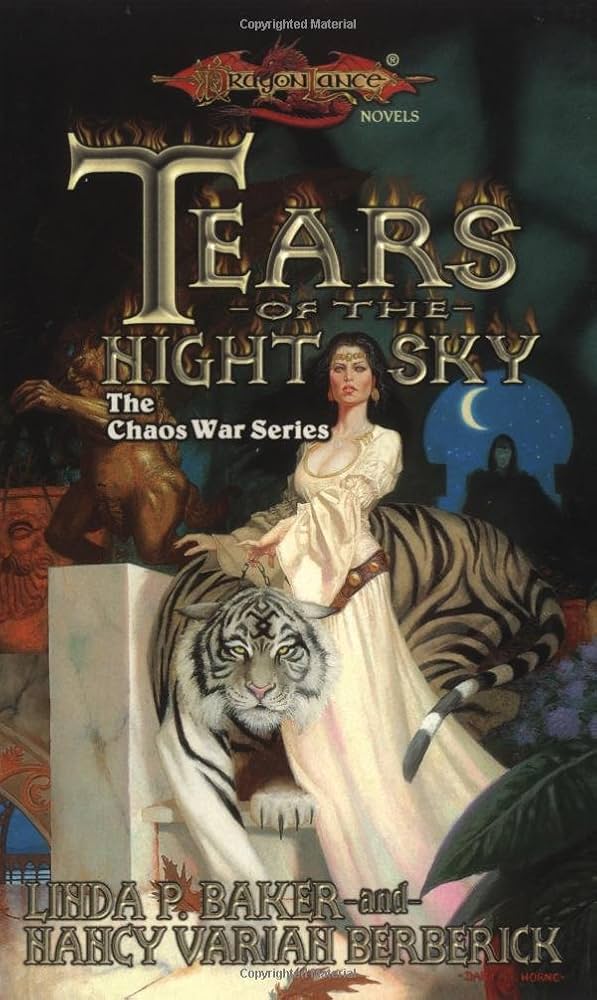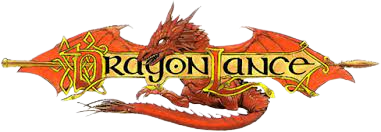Tears of the Night Sky

Table of Contents
ToggleOverview
Tears of the Night Sky is a Dragonlance Chaos War novel that explores a smaller but vital corner of the war between mortals and Chaos. It follows a disillusioned mage, a former thief turned reluctant cleric, and a goddess stripped of her power, all drawn together in a desperate quest to recover a piece of the night sky itself—a symbol and instrument of divine balance.
This is a mystical, introspective fantasy with themes of redemption, sacrifice, and the search for meaning in a world where the gods are silent and Chaos is breaking free.
Main Characters
Galdar
- A minotaur warrior, once a loyal soldier of the Dragon Highlords, now a wandering outcast.
- Physically powerful but morally burdened, Galdar seeks a new path for his life—one rooted in honor rather than conquest.
- Deeply protective and surprisingly introspective, Galdar becomes the novel’s emotional anchor.
Usha Majere
- A mysterious and powerful young woman rumored to be Raistlin Majere’s daughter.
- Wields strange magic and has a deep connection to Chaos—perhaps even born of it.
- Her presence raises cosmic questions about fate, family, and purpose.
The Goddess Nuitari (as Nuitah)
- The god of dark magic, but now trapped in mortal form, stripped of divine power.
- Her journey is about learning mortality, humility, and love, while facing the threat of annihilation.
- A rare and fascinating portrayal of a god as a flawed, growing character.
Setting
- Takes place across northern Ansalon, amid the backdrop of the Chaos War, where the fabric of reality is unraveling.
- The group travels across haunted forests, forgotten temples, and magical sites, all affected by Chaos’s encroachment.
- The sky is literally weeping—the stars are falling, and the world is cracking under the strain.
Plot Summary
The Weeping Sky
As the gods retreat and Chaos spreads, stars begin falling from the heavens—literally. One such star contains immense magical power, and may hold the key to restoring balance between Order and Chaos.
Galdar, Usha, and Nuitah/Nuitari (in mortal disguise) are drawn together by fate, prophecy, and desperation. Their quest: recover the star, prevent its power from falling into the wrong hands, and confront the growing entropy threatening Krynn.
Mortal Struggles, Divine Stakes
Their journey is not just physical—it’s deeply spiritual:
- Galdar wrestles with his past and seeks a reason to believe in something more than battle.
- Usha faces the mystery of her origin and what it means to carry Chaos in her blood.
- Nuitah, robbed of omniscience, must confront fear, doubt, and mortality for the first time.
Meanwhile, forces loyal to Chaos, and others who seek to exploit the star’s power, pursue them relentlessly.
The Truth of the Star
The fallen “star” is more than just celestial debris—it is a fragment of divine essence, capable of reshaping the world or bridging the rift between the mortal and divine. It is a symbol of hope, but also an object of temptation.
As their enemies draw closer, each character must decide:
- What are they willing to sacrifice?
- Can they let go of the past to preserve the future?
- And can Chaos be understood, or only resisted?
A Climactic Choice
In a powerful final confrontation, the characters must choose between destruction and salvation, between vengeance and mercy. The resolution is bittersweet, as they succeed—but not without loss, transformation, and deep change.
Galdar earns redemption. Usha gains clarity on her identity and role. And Nuitah, the fallen goddess, learns to love what she once ruled—mortality.
Themes
- Order vs. Chaos – Not just cosmic, but internal. Each character must face the chaos within themselves.
- Redemption and Identity – From a fallen minotaur to a miscast daughter of darkness, the novel is about becoming who you choose to be, not who you were born as.
- The Divine Made Human – Nuitah’s arc is a powerful meditation on empathy, humility, and what it means to be truly alive.
- Loss and Hope – Even as the world collapses, the novel insists that faith, love, and choice still matter.
Tone & Style
- Dreamlike, poetic, and mystical, with rich interior dialogue and magical atmosphere.
- Character-focused over action-heavy, though there are intense combat scenes.
- Often meditative, dealing with cosmic themes and existential dread, but grounded in intimate emotion.
Reception
Tears of the Night Sky is praised for:
- Its beautiful, lyrical writing and philosophical tone
- Giving depth to non-traditional heroes like Galdar and Usha
- Providing one of the most unusual and thoughtful portrayals of a god in Dragonlance
- Expanding the mythology of the Chaos War beyond armies and into spiritual terrain
Some readers note:
- It’s less traditional fantasy and more mythic/metaphysical
- The pacing is slower compared to action-driven Dragonlance books
But fans of Raistlin lore, divine themes, and emotional storytelling consider it a hidden gem in the series.
Final Thoughts
Tears of the Night Sky is a spiritually rich and emotionally satisfying fantasy novel that adds weight and wonder to the Chaos War. It’s not about armies or dragons—it’s about broken people (and gods) finding meaning in a breaking world.
Recommended for:
- Fans of Usha Majere, Raistlin’s legacy, or divine-mortal themes
- Readers who enjoy philosophical fantasy with emotional depth
- Those looking for a different kind of Dragonlance story—mystical, symbolic, and deeply human
“When the sky weeps, it is not for the gods—it is for us.”
